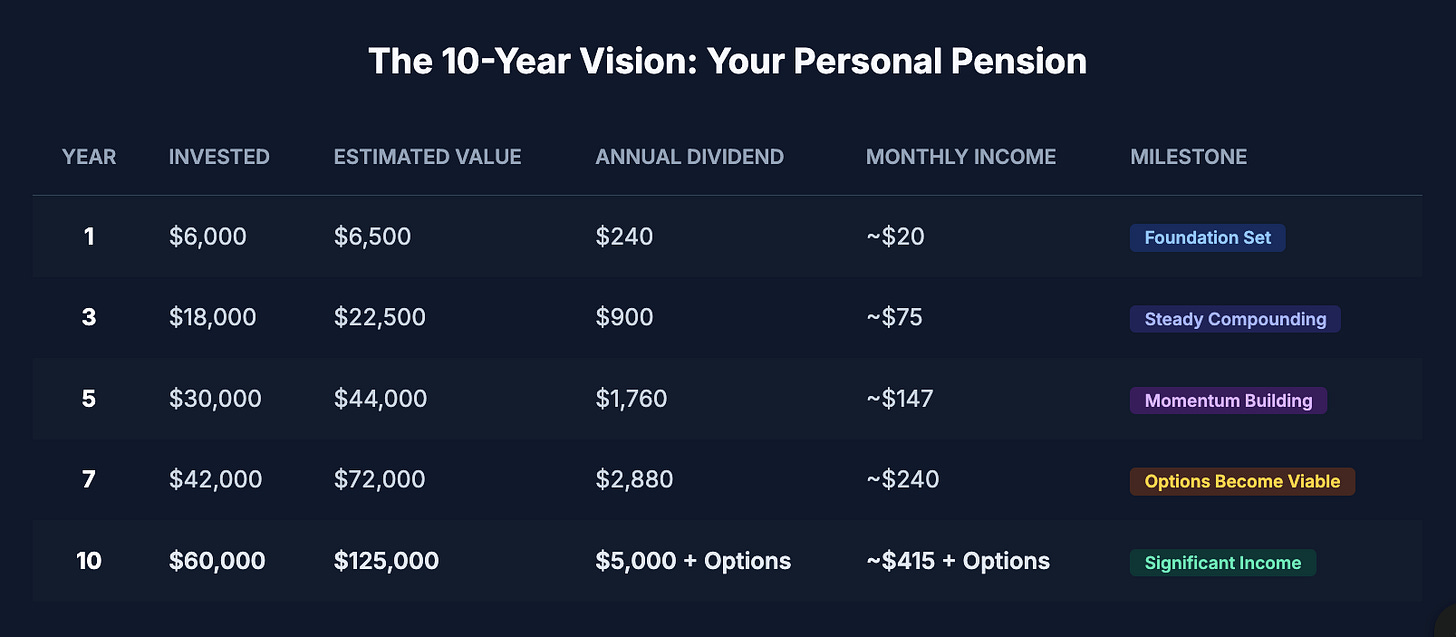If I lost everything tomorrow and had to rebuild my retirement with just $500 monthly, I wouldn't touch a single index fund.
I wouldn't buy growth stocks.
And I sure as hell wouldn't pay some suit 1.5% to manage my money.
I'd do exactly what I'm about to show you.
After two decades of managing money, I've come to believe conventional income investing has a fundamental flaw: complete dependence on portfolio appreciation.
This approach makes you hostage to market timing. You might retire into a decade-long bear market. Your withdrawal rate might coincide with a correction.
Market volatility becomes your enemy.
I'll walk you through a different strategy that removes market anxiety and creates income.
So, here's exactly how I'd manufacture a retirement paycheck from scratch with $500 a month.
Month 1: My First $500 - The Foundation
Most investors get this wrong from day one.
They're told to diversify across 47 different stocks because some blog told them it reduces risk.
That's nonsense.
In the beginning, this "deworsification" just guarantees you own a meaningless number of shares in mediocre companies.
We are going to focus on quality over quantity, establishing a concentrated portfolio of fortress-like businesses.
With our first $500, we establish our four cornerstone positions, each chosen to fulfill a specific role.
Total Monthly Income from Day 1: ~$1.62
It's a small start, but this is the first turn of the flywheel.
We are not just buying ticker symbols; we are buying fractional ownership in world-class businesses that are legally and culturally obligated to send us a portion of their profits.
Every share is a tiny employee working 24/7 to generate cash flow for our benefit.
Month 2: Steady Accumulation
For the rest of the first year, the process is mechanical.
Emotions are the enemy of returns. Doubt, greed, and fear are the assassins of long-term wealth.
We eliminate them by following a system.
The System:
Deploy Capital: Each month, $450 is deployed into the four core positions, steadily building our stake.
Build the War Chest: $50 is moved to our cash reserve. This is our "fear fund"—when the market is fearful, we will become greedy.
Reinvest Dividends: All dividends are reinvested immediately. This is non-negotiable. That $1.62 isn't spending money; it's seed capital for future income.
The goal is simple: accumulate 100 shares of each core position.
Why 100? Because a 100-share block is the standard unit for the options market.
Owning 100 shares of a stock is like owning a rental property; you can live in it, or you can rent it out for income. S
elling options is how we "rent out" our shares for a monthly fee, dramatically boosting our income potential.
That is where this strategy goes from good to great.
By the end of Month 12, the engine is built:
Total Capital Invested: $6,000
Estimated Monthly Dividend Income: ~$20
This is the quiet power of the compounding flywheel at work. More shares generate more dividends. More dividends, when reinvested, buy more shares. The wheel starts slowly, but its momentum becomes unstoppable.
Portfolio Maintenance: When a Fortress Crumbles
An engineering blueprint must account for component failure.
While we select durable companies, no business is invincible.
Therefore, we must have a protocol for portfolio maintenance.
The Protocol: We review our four core positions quarterly. A position is placed on a "watch list" and considered for replacement if it meets either of these conditions:
This disciplined approach ensures we don't hold onto a deteriorating asset out of emotional loyalty. We are ruthless in our demand for quality.
Year 2+: Igniting the Income Boosters
This is where our discipline pays off and we begin to layer on more advanced, professional-grade income streams.
Booster 1: Deploying the War Chest with Cash-Secured Puts
Our cash reserve is not for emergencies; it is for opportunities.
When markets panic, high-quality companies go on sale.
We don't panic-sell. We become the house, selling insurance to the fearful.
A real-world example: In March 2020, Microsoft (MSFT) dropped 25% on virus fears. It was a temporary crisis affecting a world-class business.
Today's Application: When a stock on our watchlist—like a Microsoft, Apple, or Visa—drops 20-25% on temporary news, we use our cash to sell a cash-secured put.
The Trade: Let's say MSFT, a ~$480 stock, drops to $400 in a market correction. We can sell one MSFT put option with a $380 strike price that expires in roughly 45 days. We choose 30-45 days because this is the sweet spot where time decay (theta) accelerates most rapidly in our favor as option sellers. For promising to buy 100 shares at $380, and with volatility elevated, we might collect a premium of around $850.
The Outcome:
If MSFT stays above $380, the option expires worthless. We keep the $850 premium as pure income. We were paid handsomely for our patience.
If MSFT falls below $380, we are forced to buy 100 shares at our chosen price of $380. Our effective cost is even lower ($371.50 per share) because we subtract the premium we kept.
This is how we get paid to buy the stocks we already wanted at a cheaper price.
Booster 2: Manufacturing Income with Covered Calls
Once we've accumulated 100 shares of a core holding like Realty Income (O), we can start selling covered calls for an additional income boost.
This is the "rent" we collect on our assets.
The Trade: We own 100 shares of O, trading at, say, $58. We sell one call option with a strike price slightly above the current price, perhaps at $60.00, that expires in a month. We specifically choose a strike with a delta around 0.30, which gives us a high (70%) probability of the option expiring worthless, allowing us to keep our shares and repeat the process.
For this, we might collect an instant premium of $50.The Outcome: We collect an instant $50. This is a new, monthly income stream layered on top of our dividends. If we do this consistently, it could add an extra 5-10% to our annual return on that position.
Around year 7, as we cross the 100-share threshold on more holdings, this "Booster" income becomes a significant contributor to our monthly paycheck.
The 10-Year Vision: Your Personal Pension
By combining these strategies, the portfolio's growth and income generation accelerate dramatically.
The path is clear, and these milestones are very tangible.
Critics will say, "You need more diversification," or "Options are too risky."
They are wrong.
They are parroting rules designed for passive investors.
I see myself as an active owner of my capital.
Concentration builds wealth; diversification preserves it.
We are in the building phase.
The strategy is simple and relentless:
Buy quality, dividend-paying assets.
Sell options against them for extra income.
Reinvest everything.
Repeat for 10 years.
The result is a self-sustaining income machine generating $415+ options per month that continues to grow every single year.
Most people either chase hot stocks or pray for market appreciation, but I’d rather start building my own pension.
Thank you for tuning in today and supporting my work!
Mike Thornton, Ph.D.










I am new to the feed. I like the strategy, looks great. Now instead of building up a portfolio of 4 stocks and waiting 7-8 years to start options, would it not be more profitable to build up a portfolio on only 2 stocks and the cash position, do the option trades and invest the faster (I think) profits to buy the other 2 stocks ? Then do options on all 4.
What do you think about PFE at the moment?